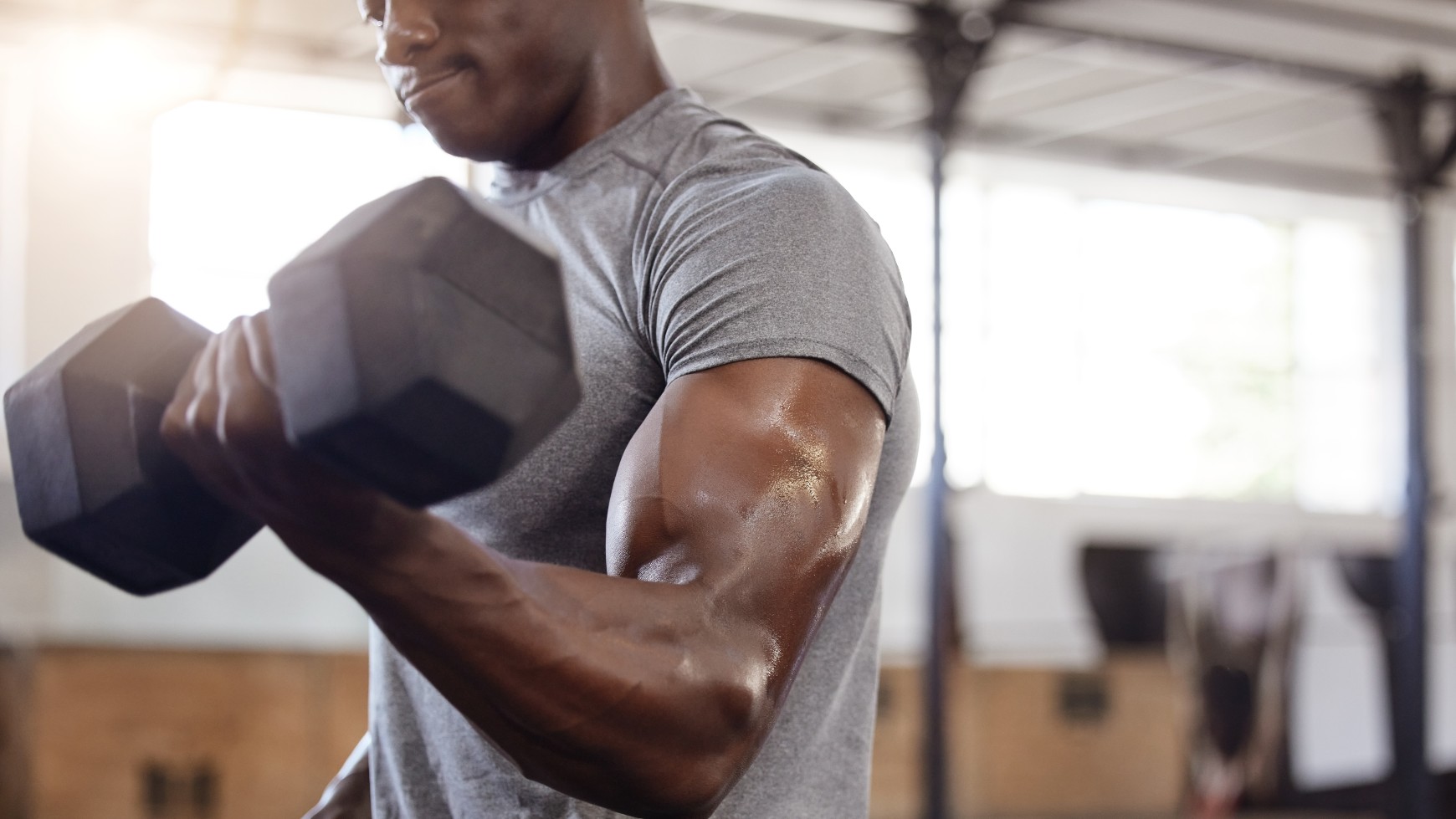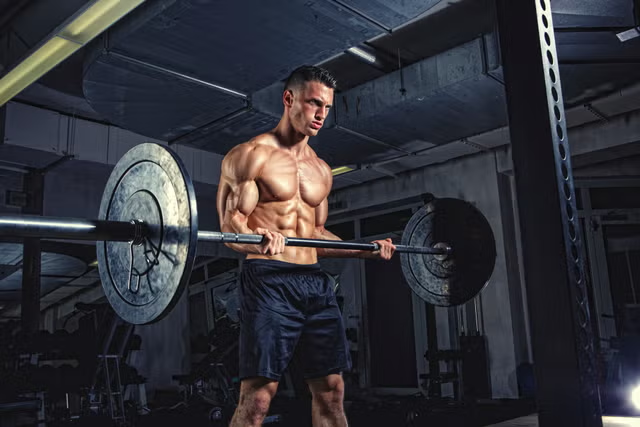The Ultimate Dumbbell-Only Biceps Workout (Gym or Home)
If you’ve got a pair of dumbbells, you’re already equipped to build bigger, stronger biceps—whether you’re training in a fully stocked gym or the corner of your living room.
Forget the fancy machines and preacher curl stations. Dumbbells are a brutally effective tool for arm growth—when used with the right strategy.
This guide delivers a complete dumbbell-only biceps training blueprint, with a laser focus on targeting every head of the biceps using deliberate angles, mechanical tension, and muscular control.
Let’s break it all down.
Why Dumbbells Are So Effective for Biceps
From a bodybuilding standpoint, dumbbells offer several key advantages over barbells, machines, and cables—especially for the biceps:
Unilateral Control
Dumbbells force each arm to work independently. That means:
- You correct size or strength imbalances.
- One strong arm can’t “cheat” for the weaker one.
- You’re forced to stabilize through a full range of motion.
Freedom of Wrist and Elbow Rotation
Dumbbells allow you to supinate (rotate your palms upward) during the curl. This is crucial because:
- Supination is a major function of the biceps.
- The more you rotate and contract, the more fibers you recruit.
- You can manipulate grip position to emphasize short head, long head, or brachialis.
Adjustable Angles and Torso Positioning
Dumbbells allow you to:
- Curl in front of your body (short head focus)
- Curl behind your body (long head emphasis)
- Use a neutral grip (brachialis and forearm recruitment)
No machines needed. No cables required. Just smart programming, clean execution, and progressive intent.
Complete Dumbbell-Only Biceps Workout
Below is a 5-exercise workout targeting every section of the biceps with just dumbbells and a bench. This program is optimized for:
- Hypertrophy
- Balance across the biceps heads
- Grip variation
- Arm thickness and shape
🔹 1. Incline Dumbbell Curl
Target: Long head of the biceps
Sets x Reps: 3 x 10–12
Key Cues:
- Set your bench to a 45–60° incline.
- Let your arms hang straight down—behind the torso.
- Curl the dumbbells slowly, squeezing at the top.
- Lower with control—3 seconds on the way down.
✅ Why it works: This movement puts the long head of your biceps on full stretch, maximizing tension in the muscle’s lengthened position—a key stimulus for hypertrophy.
🔹 2. Seated Alternating Dumbbell Curl
Target: Overall biceps, symmetrical development
Sets x Reps: 3 x 12 reps per arm
Key Cues:
- Sit upright, elbows glued to your sides.
- Curl one arm at a time, focusing on rotating your wrist as you curl.
- Supinate hard at the top and squeeze.
- Control the descent—don’t just drop the weight.
✅ Why it works: Alternating arms helps prevent momentum and allows you to focus fully on one contraction at a time, improving the quality of every rep.
🔹 3. Spider Curl (Over Bench)
Target: Short head of the biceps
Sets x Reps: 3 x 12–15
Key Cues:
- Lie face-down on an incline bench.
- Let your arms hang straight down.
- Curl straight up, pausing at the top.
- Use lighter weight and strict control—don’t swing.
✅ Why it works: Spider curls isolate the short head of the biceps and minimize body sway, allowing for an intense peak contraction.
🔹 4. Hammer Curl (Standing or Seated)
Target: Brachialis and forearm development
Sets x Reps: 3 x 10 (alternating reps)
Key Cues:
- Keep a neutral (thumbs-up) grip.
- Alternate arms or curl both at once.
- Go heavy, but maintain form—no swinging.
- Control the descent to feel the brachialis stretch.
✅ Why it works: The brachialis sits underneath your biceps. Training it makes your upper arm look thicker and pushes the biceps outward for more “pop.”
🔹 5. Zottman Curl (Finisher)
Target: Biceps + forearms
Sets x Reps: 2 x 15
Key Cues:
- Curl up with a supinated grip (palms up).
- At the top, rotate palms down and lower with a pronated grip.
- Use a slow, controlled tempo on the descent.
✅ Why it works: This movement trains both biceps (concentric) and forearms (eccentric) in one killer combo. Great for arm finishers or pump work.
At-Home Modifications (If You Don’t Have Dumbbells)
No dumbbells? No problem. You can still train your biceps at home with these tweaks:
- Use household items like:
- Backpack filled with books
- Gallon water jugs
- Canned goods or paint cans
- Slow down your tempo:
- Use a 4–5 second eccentric to increase time under tension.
- Add sets or reps:
- If load is light, go for 4–5 sets or up to 20 reps.
- Use seated variations:
- Sit against a wall or back of a chair to remove momentum.
🔥 Home Rule: What you lack in weight, make up for in volume, tempo, and precision.
Biceps Training Strategy With Dumbbells
Dumbbells may seem basic—but mastering them requires smarter programming and more attention to form. Here’s how to program and optimize your dumbbell biceps training for real results:
✅ Frequency
- Aim for 2–3 biceps sessions per week
- This can be dedicated arm days or integrated into your:
- Pull sessions
- Upper body workouts
- Push/pull/legs split
✅ Total Weekly Volume
- Target 10–14 quality working sets per week
- Spread across 2–3 sessions for better recovery
✅ Rotation of Angles
- Include curls that emphasize:
- Long head (incline curls, drag curls)
- Short head (spider curls, preacher-style movements)
- Neutral grip (hammer curls for brachialis)
✅ Tempo and Tension
- Time under tension drives growth
- Suggested tempo: 2 sec up / 1 sec hold / 3 sec down
- Always focus on control and contraction over weight
✅ Rest Periods
- 30–60 seconds between sets for metabolic stress
- Use longer rest (60–90 sec) on heavier sets like hammer curls
Progression and Overload Tips
Even with dumbbells alone, you can progressively overload your biceps training:
- Increase reps before increasing weight (especially with limited equipment)
- Add slow negatives to extend time under tension
- Use mechanical drop sets (e.g., go from incline curl → hammer curl without rest)
- Try 21s, drop sets, or pause reps for metabolic overload
- Track your volume: Weekly sets x reps x weight
🧠 Bodybuilder Mindset: When weight options are limited, technique becomes your progressive overload tool. Master it.
Final Word: Dumbbells Build Arms—If You Train With Intent
Here’s the truth that most lifters overlook: You don’t need machines, cables, or fancy gym gear to build big biceps. You just need:
- Solid programming
- Smart angle selection
- Proper tempo and control
- Consistent effort
When you train with dumbbells, you’re in full control of your tension, range, and symmetry. And that’s a good thing—because mastery of the basics beats sloppy “hardcore” training every time.
So next time you pick up those dumbbells—whether in your garage or on a gym floor—remember:
Form first. Stretch deep. Squeeze hard. Train with purpose.
And then?
Watch your arms grow.
🔗 Related Articles:
- Best Biceps Exercises Ranked
- Biceps Peak Training Guide
- Fix Biceps Training Mistakes
- Long Head vs Short Head Biceps
- Complete Arm Training Guide





